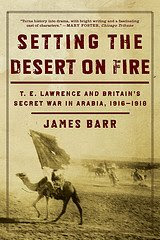 Trying to write up the day's events before it gets too dark to see - in the desert west of Mudawarra, southern Jordan, 2004
Trying to write up the day's events before it gets too dark to see - in the desert west of Mudawarra, southern Jordan, 2004Fortunately, I don't spend all my time hunting for information in the archives. It was a visit to Syria in 2002 to see the crusader castles that sparked my interest in T.E. Lawrence - and to complete the research for my book about the Arab Revolt, Setting the Desert on Fire, I then went to Jordan, and Saudi Arabia, going deep into the desert to see the places in the story for myself.
The photograph above was taken at the end of the first day of a two day trip to Mudawarra, which ninety years ago was a key railway station on the Hijaz Railway that Lawrence was anxious to destroy. Now close to the Jordan/Saudi border, the station lies in an area with abundant water supplies, and Lawrence believed that, if he could knock it out, the railway would become unusable, as the locomotives depended on water for steam.
Mudawarra lies on the Mecca road southeast of Maan, but by far the more interesting way to get there is just as Lawrence did, directly cross-country from Wadi Rum. Before I started writing the book I was keen to get more of an idea of the forty mile journey the raiders had to make to the railway, and the conditions they faced, so I organised a guide in Wadi Rum - Attayak Ali - and headed with him in a four wheel drive east out of the Wadi, and into the desert. Very quickly it feels very far from anywhere.
With a generous stop for lunch, it took about half a day to drive there, bumping across the stony, Jordanian desert, leaving a wake of yellowy-grey dust behind us. The picture above shows why, following the capture of Aqaba in July 1917, the British shipped in armoured cars and tenders to mount operations against the railway: this is (mostly) ideal country for motorised hit-and-run attacks.
We reached Mudawarra by mid-afternoon. Much of the railway station - including its all-important water tanks - was finally demolished by the British in August 1918 and what remains is now occupied by the police, who offered us a cup of tea. Then we then turned back, southwest-wards, into the desert, to find a place to spend the night.
Writing up the diary at the end of a long and hot day is invariably a chore, but it is well worth it in the long run. I find the diary reminds me far better of what the day was like than pictures I took, like the one above. It was the first time I had ventured into the desert and I was surprised by how much I had seen that day:
"The desert is not deserted. There are Bedu in their brown tents - hard to spot, and closer to the water sources in this dry season of the year [it was September]; camels loping across the desert; flies which swarm as soon as we stop; tracks of more camels, foxes, rabbits, snakes. Sand-coloured birds."
To see the debris of this forgotten battlefield you have to go much further south, however. That was why, the following year, I also went to Saudi Arabia.





1 comment:
Post a Comment